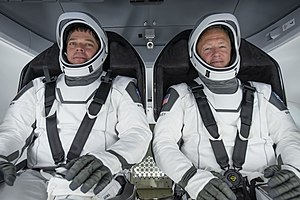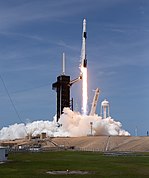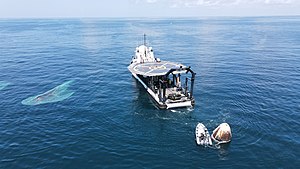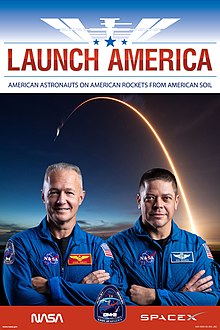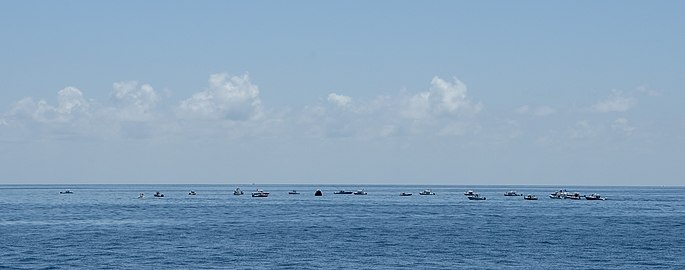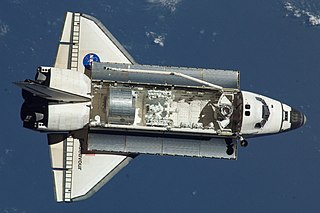
Space Shuttle Endeavour is a retired orbiter from NASA's Space Shuttle program and the fifth and final operational Shuttle built. It embarked on its first mission, STS-49, in May 1992 and its 25th and final mission, STS-134, in May 2011. STS-134 was expected to be the final mission of the Space Shuttle program, but with the authorization of STS-135 by the United States Congress, Atlantis became the last shuttle to fly.
Spacecraft call signs are radio call signs used for communication in crewed spaceflight. These are not formalized or regulated to the same degree as other equivalent forms of transportation, like aircraft. The three nations currently launching crewed space missions use different methods to identify the ground and space radio stations; the United States uses either the names given to the space vehicles or else the project name and mission number. Russia traditionally assigns code names as call signs to individual cosmonauts, more in the manner of aviator call signs, rather than to the spacecraft.

Dragon is a family of spacecraft developed and produced by American private space transportation company SpaceX. The first family member, later named Dragon 1, flew 23 cargo missions to the ISS between 2010 and 2020 before retiring. This version, not designed to carry astronauts, was funded by NASA with $396 million awarded through the Commercial Orbital Transportation Services (COTS) program, with SpaceX announced as a winner of the first round of funding on August 18, 2006.

Katherine Megan McArthur is an American oceanographer, engineer, and NASA astronaut. She has served as a Capsule Communicator (CAPCOM) for both the Space Shuttle and International Space Station (ISS). Megan McArthur has flown one Space Shuttle mission, STS-125 and one SpaceX mission, SpaceX Crew-2 on Crew Dragon Endeavour. She is known as the last person to be hands on with the Hubble Space Telescope via the Canadarm. McArthur has served in a number of positions including working in the Shuttle Avionics Laboratory (SAIL). She is married to fellow astronaut Robert L. Behnken.

Robert Louis Behnken is an American engineer, a former NASA astronaut, and former Chief of the Astronaut Office.

Douglas Gerald Hurley is an American engineer, former Marine Corps pilot and former NASA astronaut. He piloted Space Shuttle missions STS-127 and STS-135, the final flight of the Space Shuttle program. He launched into space for the third time as commander of Crew Dragon Demo-2, the first crewed spaceflight from American soil since STS-135 and became, together with Bob Behnken, the first astronaut in history launching aboard a commercial orbital spacecraft. He was also the first Marine to fly the F/A-18 E/F Super Hornet. His call sign is "Chunky", and he was sometimes referred to by this name on the communication loops.

Dragon 2 is a class of partially reusable spacecraft developed, manufactured, and operated by American space company SpaceX, primarily for flights to the International Space Station (ISS). SpaceX also launches private missions, such as Inspiration4 and Axiom Space Missions. There are two variants of the Dragon spacecraft: Crew Dragon, a spacecraft capable of ferrying four crewmembers, and Cargo Dragon, a replacement for the original Dragon 1 used to carry freight to and from space. The spacecraft consists of a reusable space capsule and an expendable trunk module. The spacecraft launches atop a Falcon 9 Block 5 rocket and the capsule returns to Earth through splashdown. It has proven to be the most cost effective spacecraft in history to be used by NASA.

Crew Dragon Demo-1 was the first orbital test of the Dragon 2 spacecraft. The mission launched on 2 March 2019 at 07:49:03 UTC, and arrived at the International Space Station on 3 March 2019, a little over 24 hours after the launch. The mission ended following a successful splashdown on 8 March 2019 at 13:45:08 UTC.

SpaceX Crew-1 was the first operational crewed flight of a Crew Dragon spacecraft, and the maiden flight of the Crew Dragon Resilience spacecraft. It was also the second crewed orbital flight launch by the United States since that of STS-135 in July 2011. Resilience launched on 16 November 2020 at 00:27:17 UTC on a Falcon 9 from Kennedy Space Center Launch Complex 39A (LC-39A), carrying NASA astronauts Michael Hopkins, Victor Glover and Shannon Walker along with JAXA astronaut Soichi Noguchi, all members of the Expedition 64 crew. The mission was the second overall crewed orbital flight of the Crew Dragon.

Expedition 61 was the 61st Expedition to the International Space Station, which began on 3 October 2019 with the undocking of the Soyuz MS-12 spacecraft. The Expedition was commanded by ESA astronaut Luca Parmitano, who became the third European and first Italian astronaut to command the ISS. Parmitano, along with his Soyuz MS-13 colleagues Aleksandr Skvortsov and Andrew Morgan, and Christina Koch from Soyuz MS-12, transferred over from Expedition 60. They were joined by Oleg Skripochka and Jessica Meir, who launched on 25 September 2019 on board Soyuz MS-15.

Expedition 63 was the 63rd long duration mission to the International Space Station, which began on 17 April 2020 with the undocking of the Soyuz MS-15 spacecraft and continued until the undocking of the Soyuz MS-16 spacecraft on 21 October 2020, an unusual double-length expedition increment. The Expedition initially consisted of American commander Chris Cassidy, as well as Russian flight engineers Anatoli Ivanishin and Ivan Vagner. On 31 May 2020, the Expedition welcomed the crew of Crew Dragon Demo-2, the first crewed flight of SpaceX's Crew Dragon spacecraft, named Endeavour after the eponymous Space Shuttle vehicle. The mission's two crew members Doug Hurley and Bob Behnken undocked from the International Space Station on 1 August 2020 to help bolster research on the station and participate in several spacewalks outside of the station.

Expedition 65 was the 65th long duration expedition to the International Space Station. The mission began on 17 April 2021 with the departure of Soyuz MS-17 and was initially commanded by NASA astronaut Shannon Walker serving as the third female ISS commander, who launched in November 2020 aboard SpaceX Crew-1 alongside NASA astronauts Michael S. Hopkins and Victor J. Glover, as well as JAXA astronaut Soichi Noguchi. They were joined by the crew of Soyuz MS-18, which is made up of Russian cosmonauts Oleg Novitsky and Pyotr Dubrov, as well as NASA astronaut Mark Vande Hei.

Ivan Viktorovich Vagner is a Russian engineer and cosmonaut who was selected in October 2010. He graduated from the Baltic State Technical University in 2008, before working as an engineer for RKK Energia.
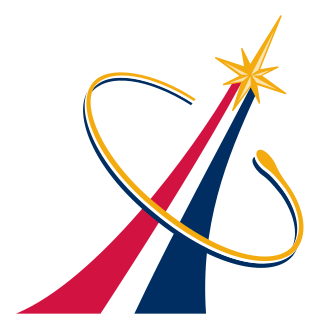
The Commercial Crew Program (CCP) provides commercially operated crew transportation service to and from the International Space Station (ISS) under contract to NASA, conducting crew rotations between the expeditions of the International Space Station program. American space manufacturer SpaceX began providing service in 2020, using the Crew Dragon spacecraft, and NASA plans to add Boeing when its Boeing Starliner spacecraft becomes operational no earlier than 2025. NASA has contracted for six operational missions from Boeing and fourteen from SpaceX, ensuring sufficient support for ISS through 2030.

Crew Dragon Resilience is a Crew Dragon spacecraft manufactured by SpaceX and built under NASA's Commercial Crew Program. In November 2020, it was launched into orbit to the International Space Station as part of the Crew-1 mission. With crew prompting, Resilience docked autonomously to the station at 04:01 UTC on 17 November 2020, or Day 2 of the mission, marking the first operational docking of a Crew Dragon and the first operational docking of the Commercial Crew Program. The mission carried four additional members of Expedition 64 to the three already on station.

Crew Dragon Endeavour is a Crew Dragon space capsule manufactured and operated by SpaceX and used by NASA's Commercial Crew Program. As of 2024 it has successfully completed four crewed missions to the International Space Station (ISS), and is currently conducting a fifth. It was first launched into orbit atop a Falcon 9 rocket on 30 May 2020 and successfully docked to the International Space Station (ISS) as part of the Crew Dragon Demo-2 mission. This was the first crewed flight test of a Dragon capsule, carrying Doug Hurley and Bob Behnken on first crewed orbital spaceflight from the United States since STS-135 in July 2011 and the first crewed orbital spaceflight by a private company. On 2 August 2020 it returned to Earth. The spacecraft was named by Hurley and Behnken after the Space ShuttleEndeavour, aboard which they first flew into space during the STS-127 and STS-123 missions, respectively. The name Endeavour is also shared by the command module of Apollo 15. The spacecraft's second mission, Crew-2, ended 8 November 2021 after having spent almost 200 days in orbit. Crew Dragon Endeavour set the record for the longest spaceflight by a U.S. crew vehicle previously set by her sibling Crew Dragon Resilience on 2 May 2021. Collectively, Endeavour has spent over 450 days in orbit, the most time in orbit by a crewed spacecraft, surpassing Space Shuttle Discovery.

SpaceX Crew-2 was the second operational flight of a Crew Dragon spacecraft, and the third overall crewed orbital flight of the Commercial Crew Program. The mission was launched on 23 April 2021 at 09:49:02 UTC, and docked to the International Space Station on 24 April at 09:08 UTC.

SpaceX Crew-3 was the Crew Dragon's third NASA Commercial Crew operational flight, and its fifth overall crewed orbital flight. The mission successfully launched on 11 November 2021 at 02:03:31 UTC to the International Space Station. It was the maiden flight of Crew Dragon Endurance.


